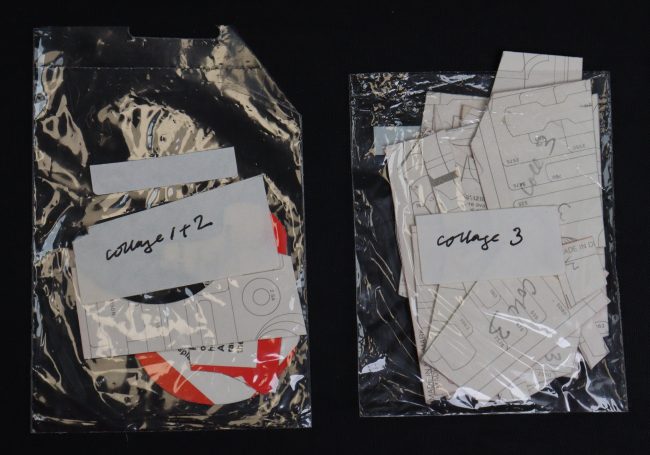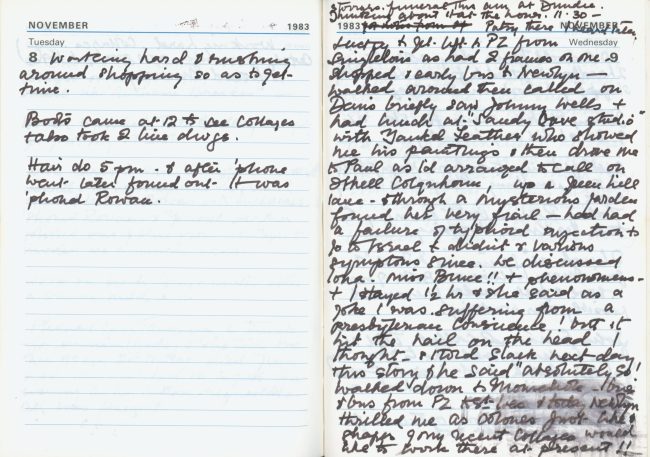A look at Collage 179, 1983
For our Picture of the Month, Jo Meacock, Trustee and Curator of British Art, Glasgow Museums, takes an in depth look at a collage from their collection alongside works from the Trust’s art collection and archive.
Fig. 1. Collage 179, or November, December 1983, acrylic and paper on board, 19.5 x 25.9 cm. Glasgow Life Museums (3458). Photo © CSG CIC Glasgow Museums Collection.
November Greys
I write this in November. The clocks have changed and darkness comes early. The light is cold and grey. The dense blacks and gradations of grey in Collage 179, alternatively entitled November, in Glasgow Museums’ collection, feel evocative of month and season (Fig. 1).
This collage, or painted relief as Barns-Graham sometimes called such works, is one of a series that the artist made between 1982 and 1987. Ill health was the initial impetus. Barns-Graham was seriously ill in 1982 and these small-scale compositions allowed her to work sitting down without physical strain. Once begun, they absorbed her imagination. In 1983 when Collage 179 was made, her diaries are full of references to their creation. On 31 January 1983 she wrote: ‘Worked on “mini collages”. With reworking etc all I seem to be doing at present: but I think they have some ideas + appeal. (I hope.)’ On 20 October 1983: ‘Worked on 2 small Relief ptgs or collages – one I greatly improved from colours to grey & a tiny new one, also grey, & began a larger one.’ By 26 October 1983 she recorded she had ‘done over 160 all different.’
Fig. 2 Wilhelmina Barns-Graham, Collage 154 (Clodgy 2), 1983, oil and acrylic on card, hardboard, 11.8 x 18.2 cm, BGT807
Captivating Clodgy
In November 1983, when Barns-Graham painted Collage 179, she was working in her Barnaloft studio in St Ives, which overlooked Porthmeor Beach. From here she could see the rocks and grassy headland of Clodgy Point. A painted relief, closely related to Glasgow’s, directly references this very landmark in its title, Collage 154 (Clodgy 2), showing that as well as painting on a small scale she was finding inspiration in the landscape immediately accessible to her (Fig. 2). Clodgy 2 suggests this wasn’t the first collage made in response to the coastline and indeed we know it was a landscape to which she returned on several occasions. On 31 October 1983 she wrote in her appointment diary: ‘began another work on Clodgy’.
Fig. 3 Wilhelmina Barns-Graham, Untitled [Clodgy Point], 1984, oil on hardboard, 30.4 x 90.9 cm, BGT1207
Sticker Stratas
A much larger representational landscape of Clodgy Point from Porthmeor Beach dating from 1984 shows a composition split into three horizontal bands – sky, headland and sea – the headland punctuated by the geometric forms of houses, dry stone walled fields and planes of rocks (Fig. 3). Does this correspond to the three distinct horizontal bands that make up Collage 154 and Collage 179? Can we see something of the rugged Clodgy headland with its rocks, buildings and enclosed pasture suggested in the slab-like formations in the mid-section of these collages? Rectangular with slightly curved corners, these blocks are actually made up of stickers placed one on top of the other, built to differing heights (Fig. 4); among Barns-Graham’s studio materials is an envelope containing cut and grouped stickers, some labelled with collage number (Fig. 5). The effect is not unlike rock strata. They become higher and more spaced out left to right, not precisely rectilinear in placement but touching, overlapping and leaning into each other suggesting structure and relationship.
Fig. 4 Detail of Wilhelmina Barns-Graham, Collage 179, or November, December 1983, acrylic and paper on board, 19.5 x 25.9 cm. Glasgow Life Museums (3458). Image © CSG CIC Glasgow Museums Collection.

Fig. 5 Labelled bags of stickers for collages from Barns-Graham's studio materials, 20T/6T/1397-8
Colours Just Like Shapes
Barns-Graham’s diary shows that her collages weren’t limited physically or inspirationally to Porthmeor and Clodgy. Her entry on 9 November 1983 demonstrates her returning physical energy and enthusiasm and reveal her making connections on her travels with the landscape around her, thinking about potential developments in her reliefs: ‘Lucky to get lift to PZ [Penzance] from Singletons as had 2 frames on me – shopped and early bus to Newlyn – walked around then called on Denis [Mitchell] briefly saw Johnny Wells + had lunch at “Sandy Cove studio” with Jankel Feather who showed me his paintings & then drove me to Paul as I’d arranged to call on Ithell Colquhoun […] walked down to Mousehole bus & bus to PZ to St Ives & today Newlyn thrilled me as colours just like shapes of my recent collages would like to work there at present!!’ (Fig. 6).

Fig. 6 Wilhelmina Barns-Graham diary, Tues 8 and Wed 9 November 1983, WBG/4/1/41
Hers was a constant observation and evaluation of the natural world, its geometry and structure, which then informed a simplified language of shape and colour. With no specific reference to place in the title, Glasgow’s collage may be inspired by Clodgy, Newlyn or another Cornish location. The way that the white paint has been brushed dryly over the central third of the composition, catching on the left-hand side of each raised section, creating bright highlights, almost suggests raking light, or even, for any familiar with coastal living, the sudden flash and withdrawal of a lighthouse beam. But the composition may be pure improvisation, Barns-Graham instinctively following the dictates of pictorial dynamics and form, developing and experimenting beyond the initial visual impetus to something much more intellectual and intangible. In 1989 she wrote: ‘After sessions of drawing, I turn my back on the experience and return to painting in the abstract, where there is a meeting point of abstracted ideas. This swing between outward observation and inward perception, or vice versa, has always increased my awareness.’
It is well known that Barns-Graham experienced synaesthesia, experience translating into colour. Did the touches of pure colour in Collage 179 – the turquoise blue, ultramarine, cobalt-like blue, fern green, cadmium-like red and orange, burnt and raw umber browns, black and titanium white – mean something specific to her, reference the landscape in some way or were they instinctively placed simply with an eye to rhythm and balance, with the confidence and experience of an innate colourist? Glasgow Museum’s painted relief is a mature exploration of colour, shape and structure, linked but not limited to observed phenomenon. The painting, with its reference to calendar month in its title, a time of year when the darkness is necessarily punctuated by bright artificial light, holds many possibilities in balance.
Fig. 7 Detail of Wilhelmina Barns-Graham, Collage 179, or November, December 1983, acrylic and paper on board, 19.5 x 25.9 cm. Glasgow Life Museums (3458). Image © CSG CIC Glasgow Museums Collection.
Small is Beautiful
In December 1983 Barns-Graham showed three of her painted reliefs (Collages 160, 161 and 168), all dated November 1983, in Small is Beautiful, a group exhibition at Angela Flowers’ Tottenham Mews gallery in London, for which artworks were limited to 9 x 7 inches (22.9 x 17.8 cm). This was the perfect venue to appreciate Barns-Graham’s collages up close in a space where they would not be overpowered by larger, showier works. Thirty were included in a single artist exhibition at the Pier Arts Centre in Orkney in August 1984, along with 50 other paintings and drawings, a show that had evolved from an exhibition at the Crawford Centre for the Arts in St Andrews in 1982, part of Barns-Graham being rediscovered in Scotland. Glasgow Museums’ collage was gifted to the collection in 1988 by a private individual, along with Small Red by Bryan Wynter, another St Ives painter. Tantalisingly there appears to be another painting on the verso of Collage 179, paint overlapping the sides from behind. The painting is firmly stuck down to one of Barns-Graham’s own painted frames but perhaps in the future we may find that we were gifted three works, not two, an alternative composition on the back – an exciting thought to cheer a dull November.
Dr Jo Meacock, Curator of British Art, Glasgow Life Museums
With special thanks to Cassia Pennington, Collections Manager and Tilly Heydon, Archive Assistant, Wilhelmina Barns-Graham Trust, and Suzanne Ross, Painting Conservator, Glasgow Life Museums.
